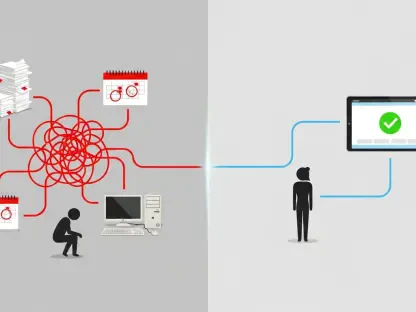Today’s business environment is more complex and unpredictable than ever, driving organizations to seek innovative approaches to risk management. The traditional models that once sufficed are now often seen as inadequate against the myriad of evolving threats, ranging from cyber vulnerabilities to supply chain disruptions. This paradigm shift has led to the emergence of Alternative Risk Solutions (ARS), which offer new avenues for flexibility and resilience in the face of uncertainty. Unlike conventional insurance mechanisms, ARS provides a bespoke approach, aligning risk strategies with an organization’s unique operational needs and long-term objectives. By focusing on proactive measures and strategic planning, ARS plays a pivotal role in equipping businesses to anticipate and mitigate risks more effectively.
The Growth of Alternative Risk Solutions
As industries continue to recognize the limitations of traditional risk management methods, the adoption of ARS has gained momentum. This shift is not merely an adjustment but a rethinking of the entire risk management landscape. ARS functions by offering solutions that cater to specific organizational needs, thus providing a strategic advantage. This is achieved through a combination of sophisticated tools such as structured solutions, parametric insurance, and captives, which together facilitate more controlled and tailored risk management. Each solution type offers unique benefits, allowing organizations to craft responses to risks that are as flexible and dynamic as the businesses themselves.
Structured solutions are particularly notable for their ability to stabilize and manage risk across multiple years. This approach mitigates exposure to market volatility, which can be a game-changer for companies facing unpredictable circumstances. Parametric insurance provides another layer of adaptability through its reliance on predefined triggers. This results in more transparent and quicker payouts, particularly beneficial in instances where timing is critical. Meanwhile, captives offer companies the autonomy to handle risks internally, ensuring a higher degree of customization and direct engagement in risk-taking decisions. By leveraging these diverse ARS options, businesses can enhance resilience and align risk management more closely with corporate goals.
Collaborative Dynamics in ARS Implementation
The implementation of ARS does not occur in a vacuum—it necessitates active collaboration between organizations and insurance partners. This partnership is crucial in crafting tailored risk management strategies that can effectively respond to unique organizational challenges. Such collaboration entails open discussions and cooperative plan development, where risk managers and insurers work closely to design innovative solutions that are comprehensive and versatile. Through these dialogues, bespoke strategies are created, ensuring that risk management is not only reactive but also anticipatory in nature, allowing companies to remain one step ahead in an ever-changing risk landscape.
Insurance partners bring a wealth of expertise and insights that are invaluable in the ARS implementation process. By sharing industry knowledge and creative strategies, they become integral to developing robust solutions that are both innovative and cost-effective. These partnerships not only focus on immediate risk mitigation but also contribute to building long-term resilience. This strategic collaboration helps businesses navigate complexities that arise from regulatory changes, technological advancements, or global market shifts, ensuring that ARS remains relevant as organizational needs evolve. Such alliances exemplify a modern approach to risk management, where adaptability and foresight are at the forefront.
The Strategic Advantage of ARS for Large Organizations
Large organizations, particularly those operating on an international scale, find ARS exceptionally beneficial due to their complex risk profiles. The diverse challenges they face across different jurisdictions require more nuanced and adaptive risk management strategies. ARS provides the flexibility and innovation necessary to address these multifaceted issues, offering a strategic advantage over traditional methods. By employing ARS, these organizations can better align their risk management practices with corporate strategies, thereby enhancing overall business efficiency and resilience.
The ability of ARS to cater to intricate risk environments stems from their customizable nature. Organizations can choose solutions that best fit their needs, ensuring that risk management is both focused and comprehensive. Furthermore, the integration of advanced data analytics in ARS provides a deeper understanding of risk factors, enabling companies to make informed decisions with greater accuracy and confidence. This strategic alignment between risk management and business objectives positions large organizations to not only mitigate risks effectively but also to seize opportunities that arise from a volatile market landscape. By prioritizing adaptability and strategic foresight, ARS allows these entities to thrive amid uncertainty.
Criteria for ARS Selection
Selecting an appropriate ARS program is a critical step that involves a thorough understanding of an organization’s unique risk landscape and strategic objectives. To achieve this, it is essential for businesses to maintain an open-minded approach towards ARS possibilities, fostering transparent communication among stakeholders. This initiative ensures that all parties, particularly C-suite executives and board members, are aligned in their understanding of how ARS strategies align with overall company goals. Consequently, a collaborative approach to solution development is advocated, where diverse perspectives contribute to crafting a comprehensive risk management framework.
The process of selecting ARS should begin with a clear identification of the organization’s risk priorities and objectives. This requires a deep dive into existing risk profiles, potential threats, and the level of risk the company is willing to assume. Once these factors are established, organizations can explore various ARS options, assessing each for its potential to address specific risk management needs. Engaging with expert consultants and insurance partners is also beneficial in this phase, as their insights and experience can guide decision-making and ensure that chosen ARS programs are robust, scalable, and aligned with long-term business strategies.
Reflecting on ARS’s Role in Future Risk Management
The evolving landscape of risk management calls for adaptive strategies that can address the complexities of a modern, interconnected world. As emphasized by industry leaders, the continuous development of ARS positions these solutions at the forefront of future risk management practices. By actively incorporating feedback and evolving alongside client needs, insurers like Liberty Mutual Insurance are pivotal in advancing ARS programs. They provide businesses with innovative ways to confront diverse risks, ensuring that risk management remains dynamic and impactful over time.
As organizations continue to face unpredictable challenges, the demand for ARS is expected to increase. These solutions offer the flexibility and strategic alignment necessary to thrive in uncertain environments, making them an indispensable component of contemporary risk management. The collaboration between businesses and insurance partners will remain critical in this process, promoting the co-creation of adaptable, client-specific solutions. In turn, ARS will enable companies to not only manage risks effectively but also to pursue new opportunities for growth and innovation in a rapidly changing global economy. Ultimately, the future of risk management lies in the ability to embrace change and harness the potential of cutting-edge innovations like ARS.









